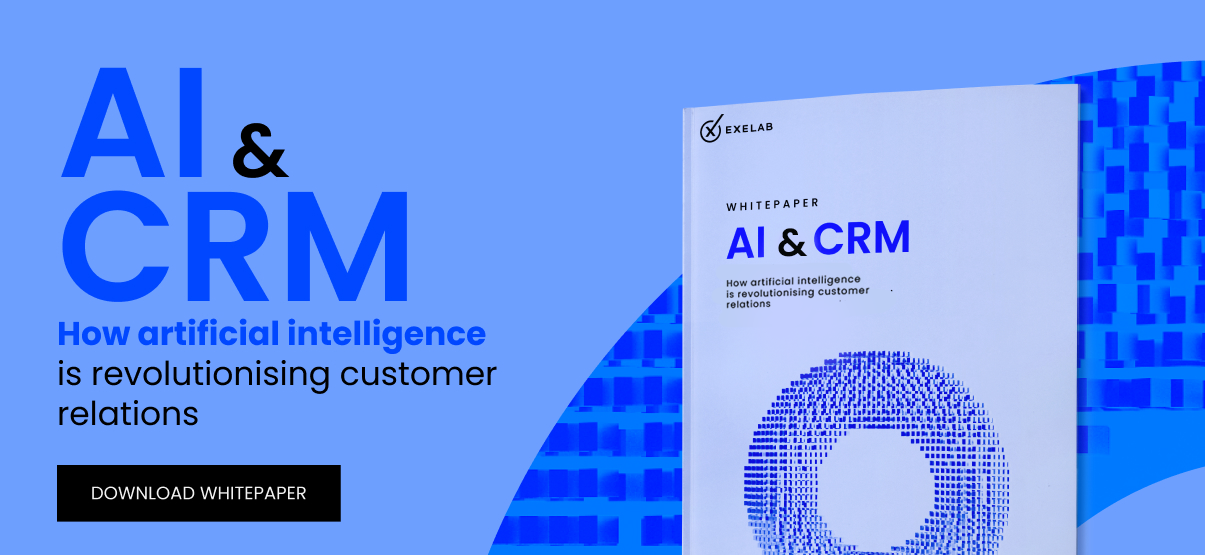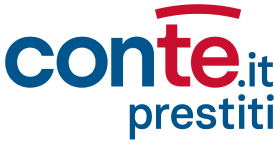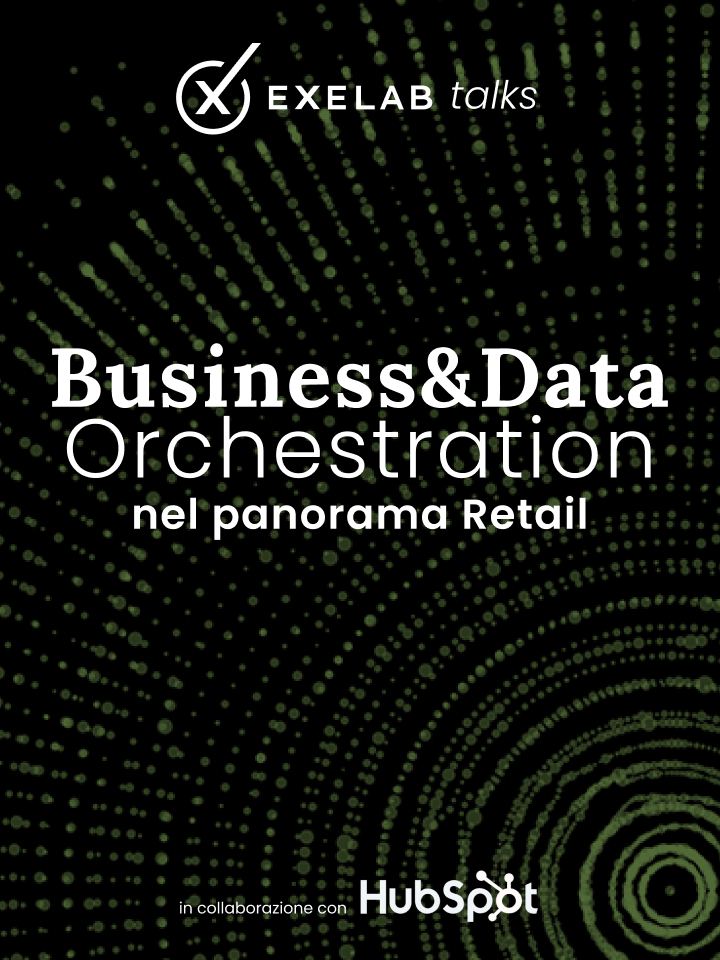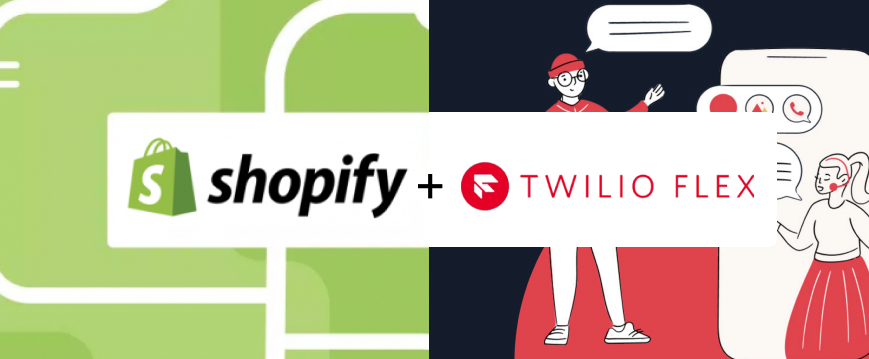
The Future of Loyalty in the Data Era
Increasingly sophisticated and personalized customer experiences...
Read moreInsights
Go to the BlogIn primo piano

The Future of Loyalty in the Data Era
Increasingly sophisticated and personalized customer experiences...
Read moreEnterprise Solutions
Recent Publications
Whitepaper

How artificial intelligence is revolutionising customer relations
Download the WhitepaperExtra
A new horizon for CRM
Automation and integration: apps

100% digital, fast and paper free processes
A new standard based on AI and HubSpot
Integrated and optimized e-commerce management with HubSpot
Exelab World
Where ideas and innovation meet
Texts to meet tomorrow's challenges
Discover our insights: visit the blog
Latest updates
Insights
Go to the BlogIn primo piano

The Future of Loyalty in the Data Era
Increasingly sophisticated and personalized customer experiences...
Read moreAbout Us
Innovation, excellence, technology: at Exelab we design the future of business processes
Exelab and The Client Group: an operational synergy to raise customer experience to the highest level
Careers
We are always looking for talent ready to make their mark: explore our opportunities
We're hiring!Exelab is an official partner of


Events
Discover our EventsMost Recent Event

Solutions
Enterprise Technology
HubSpot
Discover
About
Solutions

Exelab Solutions
Insights
Go to the BlogIn primo piano

The Future of Loyalty in the Data Era
Increasingly sophisticated and personalized customer experiences...
Read moreEnterprise Technology

Enterprise Solutions
Recent Publications
Whitepaper

How artificial intelligence is revolutionising customer relations
Download the WhitepaperHubSpot

Extra
A new horizon for CRM
Automation and integration: apps
Discover


100% digital, fast and paper free processes
A new standard based on AI and HubSpot
Integrated and optimized e-commerce management with HubSpot
Exelab World
Where ideas and innovation meet
Texts to meet tomorrow's challenges
Discover our insights: visit the blog
Latest updates
Insights
Go to the BlogIn primo piano

The Future of Loyalty in the Data Era
Increasingly sophisticated and personalized customer experiences...
Read moreAbout

About Us
Innovation, excellence, technology: at Exelab we design the future of business processes
Exelab and The Client Group: an operational synergy to raise customer experience to the highest level
Careers
We are always looking for talent ready to make their mark: explore our opportunities
We're hiring!Exelab is an official partner of


Events
Discover our EventsMost Recent Event


The attention to customer relationships and personalization within customer experience are concepts as crucial as they are often superficially treated.
Today, consumers expect to have the highest quality experiences in their interactions with brands, with most of them desiring tailor-made and personalized treatment.
In this context, what often concerns representatives of the revenue chain – from marketing, to sales, to customer care – is the fear that excessive focus on customer experience could lead to a decrease in efficiency, significantly increasing costs. But is this really the case (and should it be)?
Is there a way to reconcile process efficiency and high-quality CX, ensuring an impeccable experience for customers while simultaneously not burdening the company's finances?
In this detailed analysis, we examine the issue in light of recent studies, discussing how businesses can achieve a balance between customer experience quality and process efficiency.
If it is true that taking care of the customer experience is certainly a task that requires attention and investments that are not negligible, it is necessary at the same time to remember the factors on which this practice tends to impact directly and, potentially, exponentially.
The Customer Experience ROI Study – a study that analyzed the performance of the stocks of hundreds of companies, classified according to the CX offered (based on the main reference indices such as the Forrester Research’s CX Index) – demonstrated the following:
The impact of excellent CX varies clearly from case to case, even if the fields of the company on which it tends to act the most are the same, with benefits such as:
All these advantages reiterate the importance of investing in CX, highlighting first of all how it affects the strategic objectives of companies and why it constitutes a crucial investment for businesses.
It is necessary to eradicate the belief (as optimistic as ungrounded) that customers feel particularly attached to a brand, and that, once they have made a purchase, they are unlikely to turn their back on it in favor of another player.
The numbers highlight how it is increasingly difficult to win the 'hearts' of consumers, a factor which consequently makes it more difficult to retain your audience.
A survey conducted in 2023 on a sample of over 6500 respondents, in fact, revealed that:
These factors highlight an increasingly widespread tendency for consumers to be less attached to brands.
At the same time, this gives CX care a growing importance in making businesses stand out from their competitors, underlining how this aspect is more important than ever to achieve loyalty objectives.
In addition to what has been said, we would like to point out a piece of data of particular interest recorded by a survey of the Edelman Trust Barometer, according to which: 51% of consumers say brands fail to engage with them when their attempts result inauthentic, generic, and out of context. With similar premises, the quality of the relationship with the customer and the care he receives in his experience can only be a priority for companies.
Is it, therefore, possible to maintain high (or even increase) the efficiency of company processes, while investing in the utmost care of the customer experience?
The answer, in short, is 'yes' – it is possible to find the right balance between CX quality and efficiency, without sacrificing the quality of customer relationships, nor falling into processes that are unsustainable in the long run.
Identifying the sweet spot between process efficiency and CX customization requires following some fundamental steps, paying attention to the first in particular, without skipping ahead:
Let's see both in detail.
As within any strategy, finding the balance between the personalization of the customer experience and the efficiency of the processes requires, first of all, to be clear about the objectives you intend to achieve.
If starting from efficiency objectives risks moving us away from pursuing an excellent customer experience, to be able to bring the company towards the benefits of a well-structured CX we must first think about the objectives of the latter – even before discussing efficiency.
We need to define the final goals of CX in a crystal-clear manner, and then proceed backward, identifying the key steps and interactions that will lead to that result. What does the customer expect? What kind of experience do you want your customer to associate with your brand?
It may also be interesting to add to the equation a question about the specific way customer experience will impact business objectives.
Having a forecast of the expected return on investment will allow a more careful evaluation. This step can be considered a crucial prerequisite before thinking about efficiency improvements and automation, so as to never lose sight of the final customer experience.
The most important factor lies right here, that is, in starting from the customer's point of view to design the processes and optimize the use of technologies according to it.
While this can lead to the same results in terms of efficiency, in fact, by creating business processes with what the customer expects and the desired outcome in mind, the result in terms of CX will be significantly superior and will likely have a positive impact on the company.
Such an approach constitutes an investment that can bring benefits in the short and long term, and allows companies to adopt a crucial new paradigm, shifting attention from one's own perception to that of the customers themselves.
Having worked well on the previous point, the next step – the designing and optimization of processes – will turn out much more natural.
For example, if the objective is to help the customer achieve a certain result (like solving a problem) with the least investment of time on the part of the customer, it will be possible to design a solution that allows us to anticipate his needs.
This will have a positive impact on the experience for the customer, who will have to invest less time in resolving, but also in managing the problem itself, to the benefit of costs. How can this result be achieved?
Today, companies have large amounts of data from customer interactions with different company systems, such as from the actions that company personnel carry out to complete certain processes, from administrative and financial activities, etc. This is due to the fact that today, all (or almost all) business processes are digitized.
Thanks to this information – often surprisingly simple – it is possible to predict with a good level of accuracy the customer's next moves, as well as the possible motivations that push him to act.
For example, it is possible to predict in advance the reason why a customer is contacting us and make the most probable response available to the operator.
Or even, this allows you to be proactive and communicate to the customer the solution to his problem before he even contacts the company.
By introducing solutions that allow processes to be automated, maximum efficiency is achieved with a (potentially) positive impact on costs, without needing to accept compromises on the quality of the customer experience, resulting in a positive impact on the business.
Process automation therefore plays an important role, and today the adoption of cutting-edge technologies allows you to create an extremely personalized customer experience, while positively influencing the efficiency of customer-facing teams.
This phase plays a crucial role in the efficiency-quality duo of CX, as the adoption of the right tools is likely to exponentially impact the entire revenue chain, with consequences that are capable of impacting the entire company.
For example, some solutions allow you to manage in a single interface the interactions of the company areas that have direct relationships with the customer, and a cloud contact center that aggregates the different communication channels such as telephone, chat, WhatsApp, and email.
All of that, allowing the customer to choose his preferred channel while guaranteeing homogeneous management of requests in a single system.
This works to the advantage of the Employee Experience (which is proven to have a positive impact on CX), on the efficiency in managing requests, and on the simplification of onboarding processes for new team resources (with an impact on business scalability).
A fundamental aspect in the choice of technological tools to simplify the management of the CX of a contact center is therefore the possibility of integrating data from multiple systems into a single interface.
Starting from the data it is possible to create automation based on rules or even on machine learning and AI, which allow you to predict and anticipate the customer's needs, such as directing them to the most appropriate person in the team and providing them with the information necessary to best manage each specific case, in real-time. But how to acquire the necessary data?
The first data source is obviously the CRM which, if correctly designed and implemented, may already be integrated with all systems that contain the information needed to deliver an experience personalized to customers and with a high level of automation.
Other common sources are ERP, the Customer Data Platform (CDP), the data lake or also e-commerce, mobile apps, and web interfaces, which allow to pave the way for real-time personalization of the customer experience.
Still, it is necessary to always pay close attention because the customer experience is sometimes sacrificed for the sake of efficiency, when automation is pursued even where it adds little value.
Like any other intervention in favor of efficiency, automation should be evaluated based on the impacts it can have in relation to costs.
And when we talk about costs, a poor customer experience is the highest price a company can pay.
The crucial insights offered by the aforementioned tools allow the company to automate the automatable steps with full knowledge of the facts along the customer journey, thus maintaining high engagement along the path, but reducing the need for human intervention.
Let's analyze in more detail how technology can help to simultaneously increase efficiency and quality in managing the customer experience.

To do this, we draw on a practical case in using Twilio Flex, a contact center software that allows you to design and automate customer relations processes, and in particular on the use made of it by Shopify, the owner of the famous e-commerce platform.
Shopify had outgrown its contact center capacity due to its growth and therefore needed a scalable and tailor-made solution to manage customer relationships while guaranteeing efficiency and quality at the same time.
To do this, it leveraged Twilio Flex, implementing a customized solution within 4 months.
According to the testimony, this integration made it possible to:
Finally, Shopify has been able to exploit technology to achieve its objectives, demonstrating how it is possible to combine the highest quality of CX with high process efficiency.
.webp?width=1600&height=800&name=compressed-1600%20(2).webp)
So far, we have seen how the quality of the customer experience plays a fundamental role in achieving business objectives, and how it is possible to nurture it without negatively impacting efficiency.
At Exelab, we carefully choose our partners, offering companies the best solutions to optimize the processes of the entire RevOps chain, and helping to implement them safely and effectively, thus meeting the needs for flexibility and speed that the current market requires.
We partner with Twilio to help companies communicate with their customers in a highly personalized way, while increasing efficiency in managing customer relations and generating clear insights.
Ultimately, we think solely with a goal-oriented approach, aligning our work with the objectives of the companies we serve.
Fill out the form found at this link to be contacted as soon as possible by one of our consultants